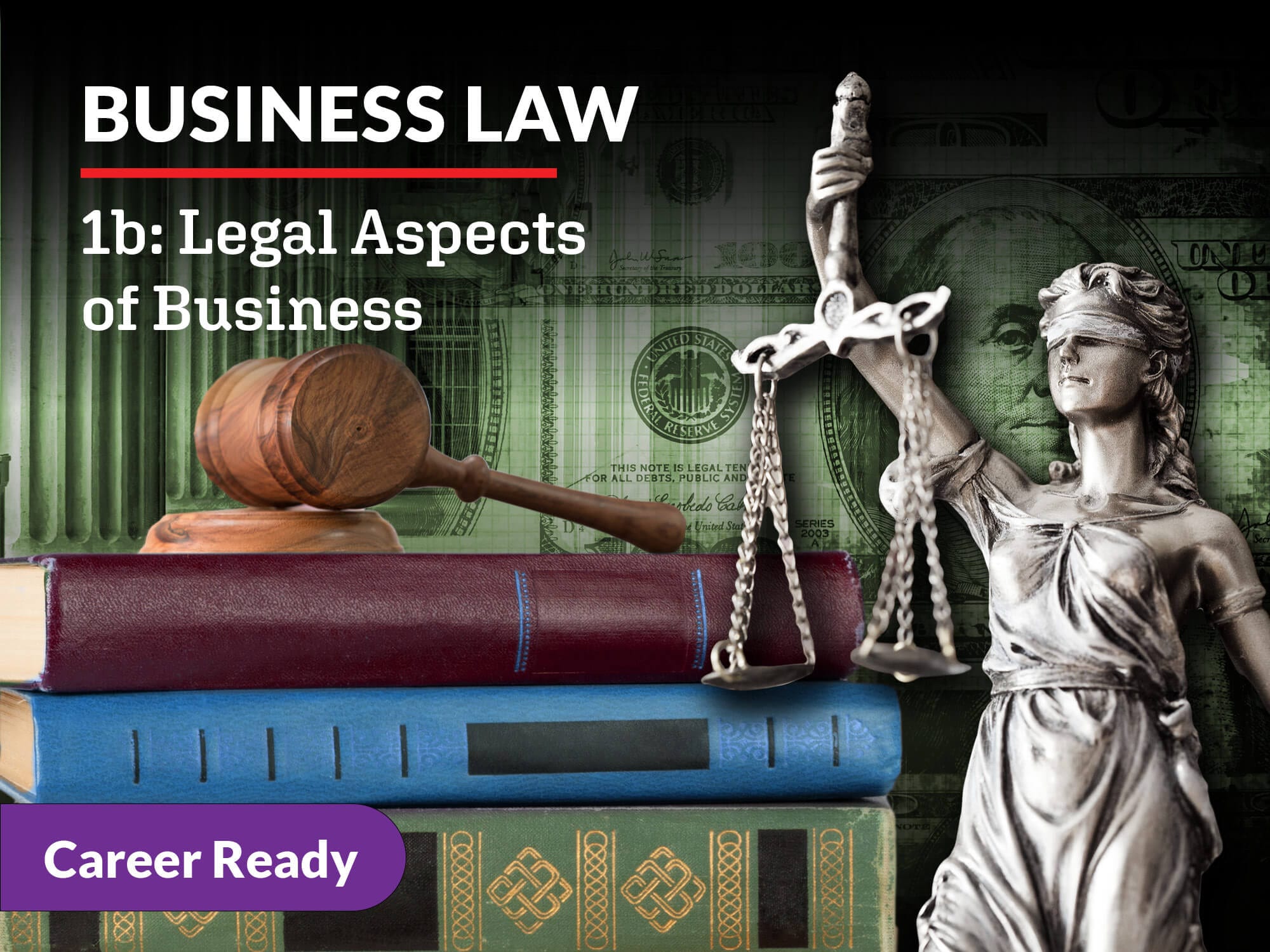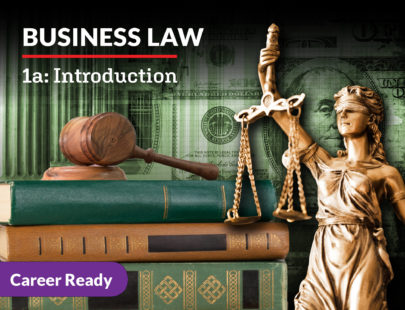
Business Law 1b: Legal Aspects of Business
Whether you plan to start your own business, work for an organization, or go into law, it’s essential to understand more complex legal requirements that impact business operations and decisions. This is especially true as companies grow and expand domestically and internationally. Explore the differences between criminal and civil law. Examine how state and federal regulations work to protect consumer and employees’ rights, protect society and the environment, and understand how business contracts can work to protect everyone.
Units at a Glance
Unit 1: More Business Law Basics
In this unit, we’ll start with the sources of laws and the differences between civil and criminal law. What makes a crime a crime? Then we’ll move on to an overview of the court system because you need to know how the courts work if you ever want to sue someone, or if you get sued, or if you or your business is accused of a crime. We’ll talk about the alternatives to taking a case to court. Finally, we’ll discuss the life cycle of a law firm. (Hint: It’s pretty similar to other service business, but it has special records-management problems.) Ready to begin?
What will you learn in this unit?
- Identify the five main sources of law
- Differentiate between criminal and civil cases
- Compare and contrast the federal and state court systems
- Argue the merits of Alternative Dispute Resolution options
- Discuss the business life cycle of a law firm
Unit 2: How Government Regulations Protect Employees’ Rights
So you’ve set up a new business and grown large enough to hire employees. You’re pretty busy, obviously, and you’re probably not thrilled that you have to understand a whole new batch of state and federal regulations that protect your employees. In this unit, you’ll learn what those regulations are and why they’re important.
What will you learn in this unit?
- Justify why the federal government regulates the employer-employee relationship
- Examine federal legislation designed to protect employees
- Evaluate how the Equal Employment Opportunity Commission (EEOC) enforces regulations that protect employees
- Assess the advantages and disadvantages of employment contracts
- Differentiate between union workers and at-will employees
Unit 3: How Government Regulations Protect Society and the Environment
The federal government oversees the public’s general welfare by regulating how companies treat employees, but its oversight doesn’t end there. The government also regulates how businesses treat the environment, even if it means corporations and investors don’t earn their full potential profits. In this unit, we explore environmental and securities regulations, both of which provide protection for society as a whole.
What will you learn in this unit?
- Assess the government’s interest in protecting the environment
- Evaluate the Environmental Protection Agency’s practices and procedures
- Interpret key legislation aimed at stemming environmental hazards
- Analyze how government oversees publicly owned businesses
Unit 4: The Ins and Outs of Business Contracts
Running a business requires making deals. When a store sells a video game to you at an agreed-upon price, the store makes money, and you get a new game. That’s a pretty simple deal, but some deals require a more complex oral or written agreement between the parties—called a contract.
In this unit, we’ll explore the laws that regulate contracts, as well as specific types of contracts, who enforces them and how, and what remedies are available if a party breaks the contract. We’ll also cover the Uniform Commercial Code, which is a collection of state laws that govern commercial transactions and sales of goods.
What will you learn in this unit?
- Discuss the elements that comprise a valid contract
- Classify various types of contracts
- Distinguish between enforceable and unenforceable contracts
- Evaluate the usefulness of the Uniform Commercial Code
- Predict the available remedies available to an aggrieved party in a contract breach
Unit 5: How Business Law Protects Consumers
“Caveat emptor” is an English proverb that means “buyer beware.” It warns consumers to protect themselves from shady sellers. Fortunately, as buyers of products and services, we’re not in it alone—we have state and federal laws to protect us from unfair business practices. Those laws require fair dealing by both parties to commercial transactions. In this unit, we explore how the law protects consumers and how consumers can protect themselves.
What will you learn in this unit?
- Identify the elements of contracts of sale of goods and the associated obligations of buyers and sellers
- Distinguish between various types of product warranties
- Describe how federal legislation protects consumers in the marketplace
- Evaluate how businesses increase profitability by using client-service strategies
Unit 6: Bribery and Beyond: How Businesses Are Perpetrators and Victims of Crime
When bad things happen to good people, shouldn’t someone have to pay? The law helps victims of wrongdoing achieve justice in the form of criminal punishment or civil liability—the responsible party pays for the harm they’ve caused. In this unit, we explore the elements of criminal and tort law, the most common business crimes and torts, and the consequences the legal system imposes on wrongdoers. We’ll also follow the judicial procedure of a criminal case from arrest to appeal.
What will you learn in this unit?
- Identify the elements of a crime
- List common business crimes
- Compare criminal and tortious conduct
- Distinguish between common torts committed by and against businesses
- Examine the steps the government takes to prosecute criminals
Unit 7: Doing Business Around the World
We now have so much information about other cultures available to us on social media and the internet that it motivates us to explore new markets for goods and services. Could that artisanal candlemaker find a supplier of glass vessels in Mexico to replace the ones no longer available from China? Can that perfume maker find a cheaper, better variety of lavender buds in the Canary Islands? Business owners are in a nonstop race to decrease costs and increase sales, so a broader global market is good for business.
But the benefits of globalization don’t end with corporate profits. Globalization gives developing nations more opportunities to grow their economies. It gives developed countries more access to ideas that help them innovate and improve technology. In fact, a global economy challenges individuals, companies, and governments to make decisions that impact lives around the world.
What will you learn in this unit?
- Understand the nature of globalization and its growth since the mid-20th century
- Examine how cultural differences impact business transactions
- Evaluate how international organizations monitor trade agreements
- Analyze the extent to which American companies operate under other nations’ laws
- Distinguish between the advantages and disadvantages of globalization
Unit 8: Winding Up a Business
You probably know of several companies that have been in business for decades or even centuries: McDonald’s has been serving hamburgers since the mid-1950s, Macy’s department stores opened in 1843, and Baker’s Chocolate started selling its sweet confections in 1765. But for every successful long-running company, there are three that failed. The US Bureau of Labor Statistics reports that nearly 20 percent of all businesses close their doors within the first two years, and only 25 percent of all new businesses make it to the 15-year mark.
Not all businesses close because they fail to make a profit. Sometimes, owners decide running a business isn’t worth the time and energy it takes to make it successful. Similarly, they may have a change of heart and want to try their hand at something new. Or the owners retire, and they don’t have someone interested in taking over the reins.
Regardless of the reasons, business owners don’t simply hang a “Closed” sign in the window and lock the front door when they decide to shut down. In this unit, we’ll examine the process of dissolving a business and what happens if the business goes bankrupt.
What will you learn in this unit?
- Understand the common reasons why businesses fail
- Describe the steps a business takes to dissolve
- Distinguish how the dissolution process is different for sole proprietorships, partnerships, and corporations
- Explain which bankruptcy option is most suitable for different forms of business
Required Materials
Physical
- Audio recording device
Software
- Word processing software
- Design software (slideshow presentation software)
- Spreadsheet software
- Recording and editing software (e.g., Audacity free version)
- Infographic creation software (e.g., Canva)



